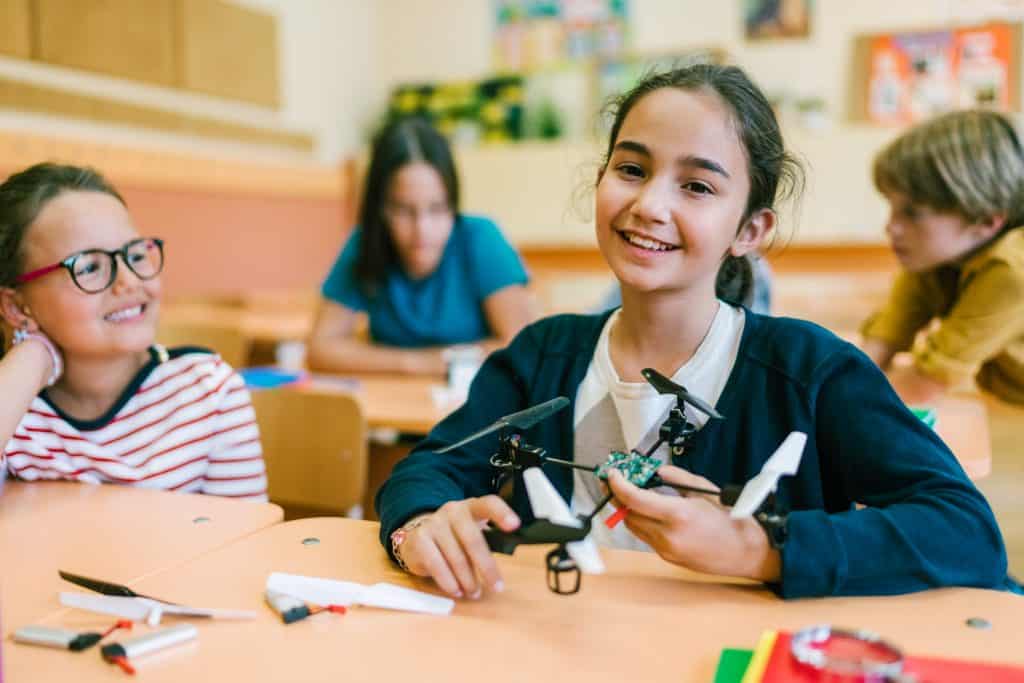Exploration of Drones: Coding with Tello (Grades 6-8)

$279.00
Students explore and apply how Unmanned Aerial Vehicles (drones) are used and function. Students will integrate algebraic thinking, programmatic knowledge, and use case scenario abstraction to control drones in Tello.
Course Description
Students explore and apply how Unmanned Aerial Vehicles (drones) are used and function. Students will integrate algebraic thinking, programmatic knowledge, and use case scenario abstraction to control drones in Tello.
Level One
- Students will be able to understand how drones are used and the laws that govern drone operation.
- Students will be able to understand the ways that block coding can be used to give instructions to machines
- Students will be able to compare scenarios for safe and unsafe drone operation.
- Students will be able to consider the reasons why drone laws would be enacted.
- Students will be able to identify components of block programming language.
- Students will be able to construct and follow a set of sequential instructions.
- Students will be able to compare sequences and loops in block coding.
- Students will be able to compare sequences and loops in block coding.
- Students will be able to understand the steps of a drone delivery and construct a simulation of a drone delivery.
Level Two
- Students will be able to compare the information collected by drone sensors to information gathered by human senses
- Students will be able to program drones to simulate the flight paths that would utilize sensors not currently included on the drone.
- Students will be able to simulate a real world flight by coding a flight pattern to scale.
- Students will be able to convert metric units for flight into imperial units.
- Students will be able to compare and contrast the relationship between drones and other tools to capture information.
- Students will be able to design a flight scenario to capture relevant scientific information.
- Students will be able to test the range of the drone in 3 dimensions and record data about the effective range of the drone.
- Students will be able to plot, in abstraction, a flight pattern that takes range and battery life into account.
- Students will be able to consider current laws regulating drone usage and their impacts on public safety as usage increases.
Standards Supported in Level I & II
Crosscutting Concepts
- Influence of Science, Engineering, and Technology on Society and the Natural World:
- The uses of technologies and limitations on their use are driven by individual or societal needs, desires, and values; by the findings of scientific research; and by differences in such factors as climate, natural resources, and economic conditions. (MS-ETS1-1).
- All human activity draws on natural resources and has both short and long-term consequences, positive as well as negative, for the health of people and the natural environment. (MS-ETS1-1)
MS-ETS1-1. Define the criteria and constraints of a design problem with sufficient precision to ensure a successful solution, taking into account relevant scientific principles and potential impacts on people and the natural environment that may limit possible solutions.
Scientific and Engineering Practices
- Asking questions and defining problems in grades 6–8 builds on grades K–5 experiences and progresses to specifying relationships between variables, and clarifying arguments and models.
- Define a design problem that can be solved through the development of an object, tool, process or system and includes multiple criteria and constraints, including scientific knowledge that may limit possible solutions. (MS-ETS1-1)
Schedule
| Program | Date | Time | Level |
|---|---|---|---|
| Drones: 6-8 Week 1 | Saturday, November 13, 2021 | 10am-11am | Level 1 |
| Drones: 6-8 Week 2 | Saturday, November 20, 2021 | 10am-11am | Level 1 |
| Drones: 6-8 Week 3 | Saturday, December 4, 2021 | 10am-11am | Level 1 |
| Drones: 6-8 Week 4 | Saturday, December 11, 2021 | 10am-11am | Level 1 |
| Drones: 6-8 Week 5 | Saturday, December 18, 2021 | 10am-11am | Level 1 |
| Drones: 6-8 Week 6 | Saturday, January 8, 2022 | 10am-11am | Level 1 |
| Drones: 6-8 Week 7 | Saturday, January 15, 2022 | 10am-11am | Level 2 |
| Drones: 6-8 Week 8 | Saturday, January 22, 2022 | 10am-11am | Level 2 |
| Drones: 6-8 Week 9 | Saturday, January 29, 2022 | 10am-11am | Level 2 |
| Drones: 6-8 Week 10 | Saturday, February 5, 2022 | 10am-11am | Level 2 |
| Drones: 6-8 Week 11 | Saturday, February 12, 2022 | 10am-11am | Level 2 |
| Drones: 6-8 Week 12 | Saturday, February 19, 2022 | 10am-11am | Level 2 |